Welcome to the Ranch
Posted on Sun., Oct. 1, 2017 by
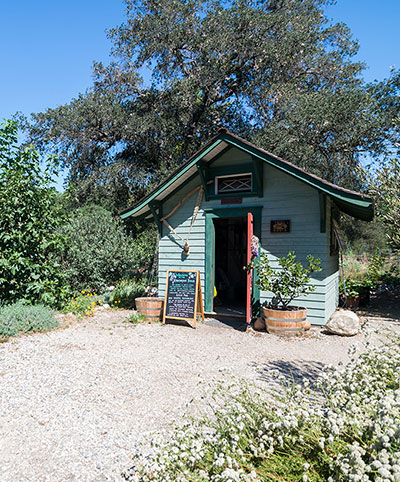 Left: A chalkboard outside the "Tool Booth" welcomes visitors to the Ranch Garden. Photograph by Kate Lain.
Left: A chalkboard outside the "Tool Booth" welcomes visitors to the Ranch Garden. Photograph by Kate Lain.
The Huntington's experimental demonstration garden educates and enchants
If ever there were a secret garden, it's the Ranch Garden at The Huntington.
The place can be a bit hard to find. It's tucked behind the Helen and Peter Bing Children's Garden, past a string of working greenhouses, well off the beaten path. And it's open to visitors only on Saturdays (10 a.m. to 1 p.m.).
But you'll know it when you find it. Walk under the shade of some stately oaks, through a humble gate, and you'll see—depending on the season—fruit trees laden with plums and apricots, vines bursting with melons, and towering tomato plants. You may find a bower dripping with grapes, leafy artichokes as high as your waist, or tomatillos blooming amid a riot of sunflowers. You'll hear bees buzzing and the songs of wrens and warblers. If you're lucky, you'll see monarch and swallowtail butterflies and maybe one of the lizards, or even bunnies, that call the Ranch their home.
Part demonstration garden, part experimental space, and part pure magic, the Ranch is full of folksy touches like straw bales and a sign reading: "Trespassers will be composted." With its abundance of edibles and a slightly unkempt, playful air, the Ranch is decidedly different from the more manicured, formal, ornamental gardens that grace the rest of The Huntington.
"It's a different kind of beauty," says Jim Folsom, the Marge and Sherm Telleen/Marion and Earle Jorgensen Director of the Botanical Gardens. One of the primary goals of the Ranch, Folsom says, is not creating something that requires expensive landscape architecture or a large crew of caretakers. Instead, the Ranch showcases simple but effective ideas home gardeners might employ in their own yards. "The goal back here," Folsom says, "is humility."
The Ranch Garden got its start with 80 homeless fruit trees that arrived when the nation's largest urban farm, South Central Farm in Los Angeles, closed in 2006. The Huntington agreed to temporarily house the treasured trees in boxes, until a new farm site could be found. When that fell through, the institution agreed to plant the trees as part of a demonstration space for urban gardening, funded with a grant from the Annenberg Foundation. The Otis Booth Foundation and Huntington Overseer Stephen E. Rogers have provided additional funds.
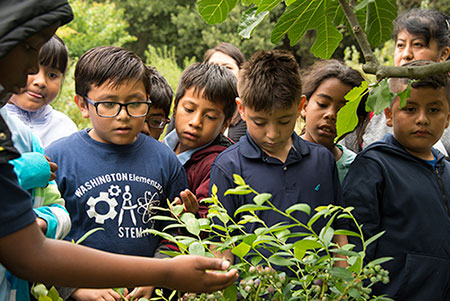 Right: Second graders from Washington Elementary in Pasadena, Calif., on a spring visit to the Ranch. Photograph by Kate Lain.
Right: Second graders from Washington Elementary in Pasadena, Calif., on a spring visit to the Ranch. Photograph by Kate Lain.
The garden, says Folsom, is an opportunity for The Huntington to get back to the property’s agricultural roots—a legacy that was lost over the years as the focus shifted to ornamental and rare plants. “The Ranch” is what Henry E. Huntington originally called the working farmstead he bought in 1903. Huntington planted orange groves and was among the first in the state to farm avocados. He maintained a kitchen garden as well.
Today, the 15-acre Ranch site includes some of Huntington’s original orange groves, a heritage avocado orchard, a “food forest,” and room for a kitchen garden, or potager, about to get underway. At the heart of the Ranch is a half-acre demonstration site and working vegetable garden used to educate the public about sustainable urban gardening, a practice that’s become increasingly important in recent years.
“People are interested in food and where it comes from,” says Aaron Fox, assistant professor of urban and community agriculture at California State Polytechnic University, Pomona. “But there are a lot of roadblocks. Having a demonstration space like The Huntington’s Ranch may open a lot of doors and show people there are simple ways of integrating gardening into their own lives.”
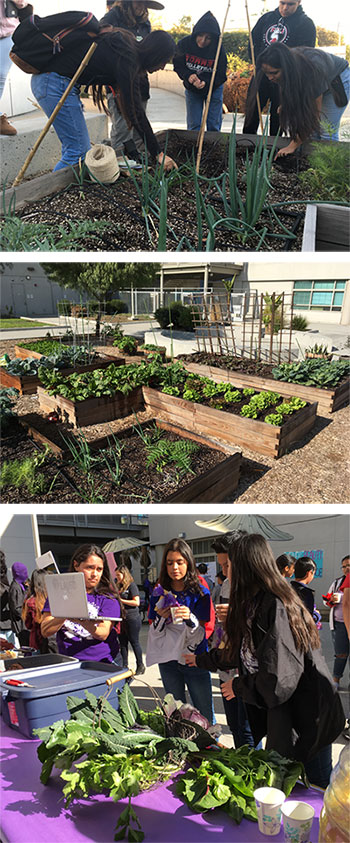 Top: High school students from the Torres Garden Club at East Los Angeles Renaissance Academy visited the Ranch before planting vegetables on their school campus. Center: Several of the Torres Garden Club’s raised vegetable beds basking in the sun. Bottom: The Torres Garden Club students produced so many vegetables that they sold them at their high school to raise funds. Photographs by Natasha Burgos.
Top: High school students from the Torres Garden Club at East Los Angeles Renaissance Academy visited the Ranch before planting vegetables on their school campus. Center: Several of the Torres Garden Club’s raised vegetable beds basking in the sun. Bottom: The Torres Garden Club students produced so many vegetables that they sold them at their high school to raise funds. Photographs by Natasha Burgos.
Each Saturday during open house, you’ll find volunteer master gardeners from throughout Los Angeles County showcasing the bounty of the Ranch. At a recent one, visitors sample dark red mulberries and Australian finger limes—thin, dark citrus fruits that explode pleasantly on the tongue. “It’s like caviar!” one taster says. An 11-year-old visitor from Arizona, meanwhile, tears into a plate of fresh radishes.
“Everyone likes to try the food,” says Chan Nguyen, a master gardener and Huntington volunteer from Eagle Rock who relishes her stints at the Ranch. “It’s very serene and magical,” she says. “It’s so different from the rest of The Huntington. You almost feel like you’re breaking the rules.”
Visitors pepper master gardener with questions. How hard is it to build raised beds? How high should they be? Can I grow grapes on the side of my garage? Many seem impressed by how rich, ripe, and lush everything is—and how different from stereotypical vegetable gardens with tidy rows. “I would say people are surprised—and delighted,” says Joan Borgman, a volunteer and master gardener from North Hollywood.
On many weekdays, the Ranch hosts some of its most enthusiastic visitors. Hundreds of second-graders from Pasadena Unified School District visit The Huntington through the school year as part of the district’s Farm to School program, which emphasizes growing and eating healthy produce. At the Ranch, they often can’t control their excitement.
“Hey, I see hay!” shouts one student, cracking up his classmates. “Blueberries!” yells Victor Hernandez, 7. “They look like they have juice inside!” The kids seem stunned to see a tiny watermelon forming on a vine. They thought pomegranate flowers would form cherries. It is clear many in the group don’t associate the foods they eat with the plants that grow them.
“A lot of this is new to them, that’s why they’re freaking out about the berries,” says teacher Karina Evans. “They know zucchini, they know pumpkin, but not how they are grown.”
“They get excited about seeing where their food comes from,” agrees Deborah Hartnett, a master gardener from Inglewood who leads school tours. Hartnett says she’s seen children astonished when given the chance to pull a carrot from the soil. “I’m hearing they eat more vegetables if they grow them,” she says.
That’s true of Jesse Ramirez, 8, who helps her parents tend a small vegetable garden on the balcony of their apartment. “We grow carrots, tomatoes, cabbage, and cucumbers,” she says. “I make the salad. I chop everything.”
Older students benefit, too. High school students from the Torres Garden Club at East Los Angeles Renaissance Academy visited the Ranch before planting six raised beds on their campus. They planted Brussels sprouts, kale, and beets; built bamboo teepees to support snap peas; and grew strawberries, tomatoes, and artichokes. They ended up with so much produce that they made and sold lunches to teachers as a fund-raiser.
The experience has been transformative for the teenagers—some of whom are top students. Some have learning disabilities, emotional problems, or have run into trouble with the law, says garden club advisor and teacher Natasha Burgos. They’ve taken to gardening with a vengeance—racing to the Internet to solve problems, like why artichokes aren’t blooming or how to keep birds from eating strawberries. “It helps them figure out things on their own,” Burgos says. “They see if they put in the time and the work, they get results.”
The Ranch is also a lab and experiential learning center for college students studying urban and community agriculture, like Emma Ho’o, 26, a plant science major from Cal Poly Pomona.
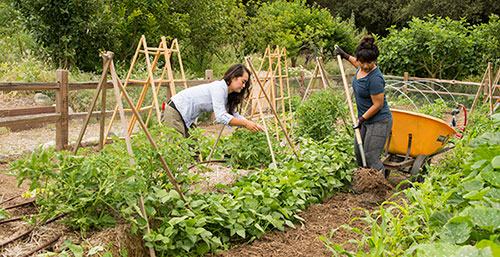 Right: Kelly Fernandez (left), gardener at The Huntington’s Herb Garden, builds a framework to support vegetables growing in straw bales at the Ranch Garden, while Emma Ho’o, a plant science major from Cal Poly Pomona, spreads mulch between the rows. Photograph by Kate Lain.
Right: Kelly Fernandez (left), gardener at The Huntington’s Herb Garden, builds a framework to support vegetables growing in straw bales at the Ranch Garden, while Emma Ho’o, a plant science major from Cal Poly Pomona, spreads mulch between the rows. Photograph by Kate Lain.
Ho’o is ambitious. She wants to run a kitchen garden attached to a Michelin-starred restaurant like Copenhagen’s famed Noma and calls her work helping with the Ranch vegetable patch “horticultural therapy.”
“It shows the ease and joy of growing your own food,” she says. “You can see how much—even in a small place—you can produce.”
Carolina Vaquerano, 26, is a Mt. San Antonio College student who hopes one day to open an urban farm using techniques she’s learning at the Ranch. On a recent Sunday, she’d driven more than an hour to tackle such unglamorous tasks as weeding and mulching. But she keeps returning, she says, because “It’s a magical place.” “I can explore,” she adds. “I can hide in places and eat fruit. When I’m here I feel like a little kid again.”
Kelly Fernandez’s main job is to care for The Huntington’s Herb Garden, with its formal structure, brick paths, and ordered plantings of heliotrope and borage that recall European gardens of past centuries. But Fernandez, an obsessive vegetable gardener, has been known to sneak in the occasional kale, chard, or eggplant. “The docents always ask me, why are there vegetables in here?” Fernandez says.
But in the annuals bed at the Ranch, Fernandez is able to grow vegetables, in all their mess and glory, to her heart’s content. She can create playful plant tapestries, for example, combining tomatillos, hot peppers, basil, and edible sunflowers into one gorgeous patch. She can let pole beans run up corn-stalks and flowers grow amidst rainbow chard.
“The Ranch is more playful,” she says, deftly cutting a knee-high bunch of beet greens from amid a swirl of squash vines. “It’s a little looser.”
One fan is David “Mas” Masumoto, the noted author and organic peach farmer, who visited the Ranch after lecturing at The Huntington last spring. “You look at that garden, there’s so much joy,” he says. “This is not industrialized, corporate farming. This is an oasis.”

Left: Cara Hanstein, the Ranch’s chief gardener, plucks a white mulberry from a tree at the Ranch. Photograph by Kate Lain. Right: This massive, diesel-fueled tub grinder converts tons of plant waste from across The Huntington’s campus into giant piles of mulch. Photograph by Kate Lain.
Indeed, the fanciful selection of fruit trees planted here seems an invitation to feast. There are coffee cake persimmons. Red strawberry guavas. Pink lemonade blueberries. Even bacon avocados.
Folsom hopes such wondrous abundance encourages homeowners to plant something of their own. “You need to drop your fears and just do it,” he says. “If you live here and have space but go to the store to buy rosemary and lemons, that’s just weird.”
One Ranch project that home gardeners could easily try is planting vegetables in pockets of soil nestled inside straw bales. The bales break down into compost as the plants inside them grow. And with so much aeration, growing conditions can be excellent.
“It’s all the rage right now, so I wanted to try it,” says Fernandez, who was eagerly anticipating cutting the strings holding the bales together at season’s end. “Inside is this luscious, wonderful new soil that’s been forming in there,” explains Ho’o, who had planted with bales the season before.
“We’re all soil nerds,” Fernandez says. Which is good, because at the Ranch, says Folsom, “soil is queen.” It’s amended, aerated, and mulched as much as possible. Visitors are asked not to step on the soil in growing beds so as not to compact it.
That soil is carefully tended by the Ranch’s chief gardener, Cara Hanstein, who is so good with plants, volunteers say she has “magic dust in her fingers.” But Barnard humbly attributes her success to the healthy soil and its many microbes. “Taking care of soil is definitely the future of gardening,” she says. “Which is a little bit silly because it’s also the past of gardening.”
The Ranch’s original soil needed a lot of help. It was severely compacted by the many trucks that had parked on it during construction of the Chinese Garden and was riddled with gravel. Gardeners and interns—including Fernandez, who got her start at The Huntington by interning—spent months layering the ground with cardboard and mulch to rehabilitate the soil.
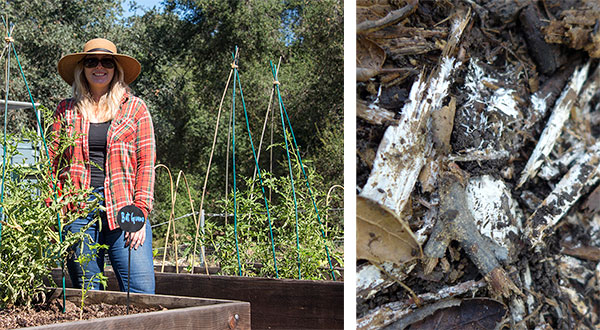 Left: Alicia Baugh, head of The Huntington’s plant sale nursery, stands between raised beds at the Ranch where she tests soil amendment. Photograph by Kate Lain. Right: Beneficial fungi spread through mulch, slowly breaking it down. Photograph by Lisa Blackburn.
Left: Alicia Baugh, head of The Huntington’s plant sale nursery, stands between raised beds at the Ranch where she tests soil amendment. Photograph by Kate Lain. Right: Beneficial fungi spread through mulch, slowly breaking it down. Photograph by Lisa Blackburn.
Cardboard mulching has many merits: it kills weeds, draws beneficial fungus into the soil as it breaks down, and conserves water. If you look closely while at the Ranch, you might see some cardboard peeking up from under wood chip mulch. “See how it really retains the moisture?” Barnard asks, lifting up the corner of a cardboard sheet for a visitor. “It’s been so hot. But not under here.”
Hanstein needs an almost unimaginable amount of mulch to keep her soil in top shape. Luckily, Daniel Goyette can provide it. Goyette, The Huntington’s principal arborist, deals with the tons of plant waste that a 207-acre property generates. He grinds towering piles of material— thick oak trunks, palm fronds, lengthy bamboo stems—in a massive, diesel-powered tub grinder with a 75-foot-long conveyor belt—into giant piles of wood chip mulch.
Truckloads of that mulch are then ferried to the Ranch—and elsewhere on the property, as more and more Huntington gardeners clamor for it. It’s one example of how the stewardship and sustainability efforts showcased at the Ranch, like heavy mulching and the reduction of water use, are winding their way through The Huntington at large.
While the Ranch features an edible landscape, the garden also stresses the importance of nurturing habitats that support wildlife and pollinators. Key to this are the many California native plants—verbena, salvia, penstemon, and Matilija poppies—that look right at home amidst the vegetables. “It’s thinking about gardening in a whole new way,” says Kitty Connolly, executive director of the Theodore Payne Foundation for Wild Flowers and Native Plants and former botanical educator at The Huntington. The use of California natives throughout the Ranch, Connolly says, is “a seal of approval that natives have arrived and are an accepted part of our aesthetic landscape.”
The Ranch is also the place where Huntington gardeners can try new ideas with little fear of how messy the results may look. “We are constantly experimenting with things you hear in the field of horticulture,” Hanstein says. “We are always observing, watching as the garden unfolds and responds.”
There’s the “spontaneous garden” where a volunteer once threw a handful of leftover seeds. It was recently brimming with drifts of chard and bachelor’s buttons that were battling off a small invasion of New Zealand spinach. An experimental “food forest” in the rear of the Ranch—an attempt to create a permanent ecosystem of fruit trees and edible perennials with little maintenance—has been more of a struggle because hardy weeds and grasses compete with the food plants.
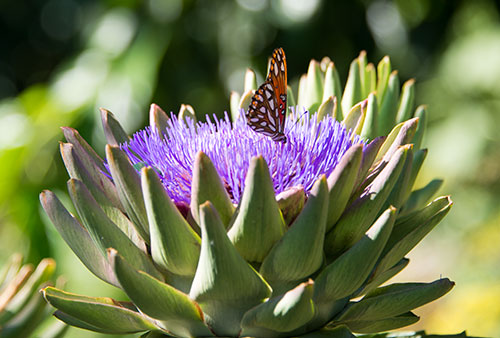 Right: A pollinator attracted to an artichoke flower in full bloom at the Ranch. Photograph by Kate Lain.
Right: A pollinator attracted to an artichoke flower in full bloom at the Ranch. Photograph by Kate Lain.
But new ideas keep rolling in: Folsom is dreaming up a hundred ways to use “square foot gardening” in raised beds for school curricula. He’s also testing various ways schools might easily grow potatoes in containers large and small. “I think of this as an idea space,” he says.
Alicia Baugh, head of The Huntington’s plant sale nursery, is using raised beds at the Ranch to test which soil amendment—seaweed extract, bat guano, or organic, all-purpose fertilizer—works best to boost vegetable growth. Baugh, Fernandez, Goyette, and other botanical staff who help at the Ranch have full-time jobs at The Huntington unrelated to it, Folsom notes. But, like many volunteers, they can’t seem to keep away. “I love it,” Baugh says. “I love that it’s more like your own backyard.”
“It feels like a community effort,” says Hanstein, who encourages people to test an idea at the Ranch, use it as a classroom, or just visit it to enjoy the scent of blooming sage, the crunch of soil under their feet, and the vivid palette of colors that change through the seasons. “This wildness,” she says. “It’s something people crave—even if they don’t realize they crave it.”
Usha Lee McFarling is a Pulitzer Prize–winning freelance writer based in South Pasadena, Calif.